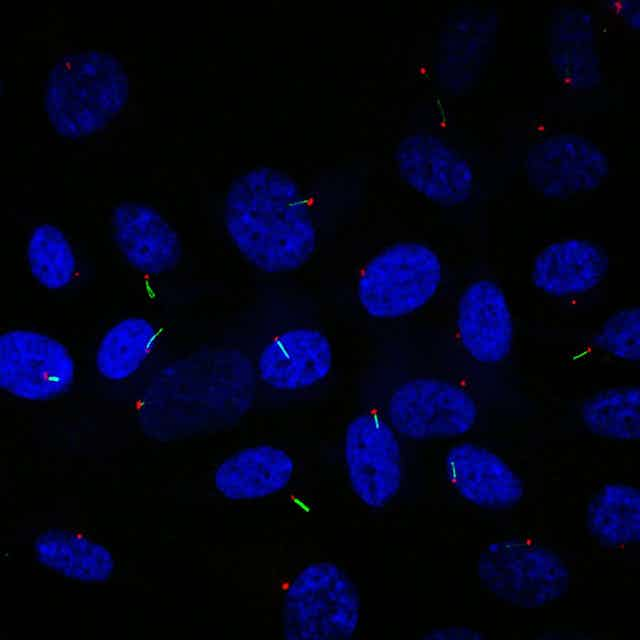You might know that our lungs are lined with hair-like projections called motile cilia. These are tiny microtubule structures that appear on the surface of some cells or tissues. They can be found lining your nose and respiratory tract too, and along the fallopian tubes and vas deferens in the female and male reproductive tracts. They move from side to side to sweep away any micro-organisms, fluids, and dead cells in the respiratory system, and to help transport the sperm and egg in the reproductive system.
Odds are, however, that you haven’t heard about motile cilia’s arguably more important cousin, primary cilia.

Primary cilia are on virtually all cells in the body but for a long time they were considered to be a non-functional vestigial part of the cell. To add to their mystery, they aren’t present all the time. They project from the centrosome – the part of the cell that pulls it apart during division – and so only appear at certain stages of the cell cycle.
The first sign that these little structures were important came with the realisation that disruption to either their formation or function could result in genetic conditions known as ciliopathies. There are around 20 different ciliopathies, and they affect about one in every 1,000 people. These are often disabling and life-threatening conditions, affecting multiple organ systems. They can cause blindness, deafness, chronic respiratory infections, kidney disease, heart disease, infertility, obesity, diabetes and more. Symptoms and severity vary widely, making it hard to classify and diagnose these disorders.
So how can malfunction of a little organelle which was originally thought to be useless result in such a wide variety of devastating symptoms? Well, it is now known that not only do cilia look like little antennas, they act like them too. The cilia is packed full of proteins that detect messenger signals from other cells or the surrounding environment. These signals are then transmitted into the cell’s nucleus to activate a response – for example, these responses are important for the regulation of several essential signalling pathways.
When this was realised, researchers began to ask whether changes in the structure or function of cilia; changes in protein levels associated with cilia; or movement of these proteins to a different part of the cell could occur due to – or potentially drive – other conditions. Given that scientists already knew then that many of the pathways regulated by cilia could drive cancer progression, looking at the relationship between cilia and cancer was a logical step.
Cilia, signals and cancer
Researchers discovered that in many cancers – including renal cell, ovarian, prostrate, breast and pancreatic – there was a distinct lack of primary cilia in the cancerous cells compared to the healthy surrounding cells. It could be that the loss of cilia was just a response to the cancer, disrupting normal cell regulation – but what if it was actually driving the cancer?
Melanomas are one of the most aggressive types of tumours in humans. Some cancerous melanoma cells express higher levels of a protein called EZH2 than healthy cells. EZH2 suppresses cilia genes so malignant cells have less cilia. This loss of cilia activates some of the carcinogenic signalling pathways, resulting in aggressive metastatic melanoma.
However, loss of cilia does not have the same effect in all cancers. In one type of pancreatic cancer, the presence – not absence – of cilia correlates with increased metastasis and decreased patient survival.
Even within the same cancer the picture is unclear. Medulloblastomas are the most common childhood brain tumour. Their development can be driven by one of the signalling pathways regulated by the cilia, the hedgehog signalling pathway. This pathway is active during embryo development but dormant after. However, in many cancers (including medulloblastomas) hedgehog signalling is reactivated, and it can drive cancer growth. But studies into the effects of cilia in medulloblastomas have found that cilia can both drive and protect against this cancer, depending on the way the hedgehog pathway is initially disrupted.
As such strong links have been found between cilia and cancer, researchers have also been looking into whether treatment which targets this structure could be used for cancer therapies. One of the problems faced when treating cancers is the development of resistance to anti-cancer drugs. Many of these drugs’ targets are part of the signalling pathways regulated by cilia, but scientists have found that blocking the growth of cilia in drug-resistant cancer cell lines could restore sensitivity to a treatment.
What was once thought to just be a cell part left over during evolution, has proven to be integral to our understanding and treatment of cancer. The hope is that further research into cilia will help untangle the complex relationship between them and cancer, and provide both new insights into some of the drivers of cancer as well as new targets for cancer treatment.

